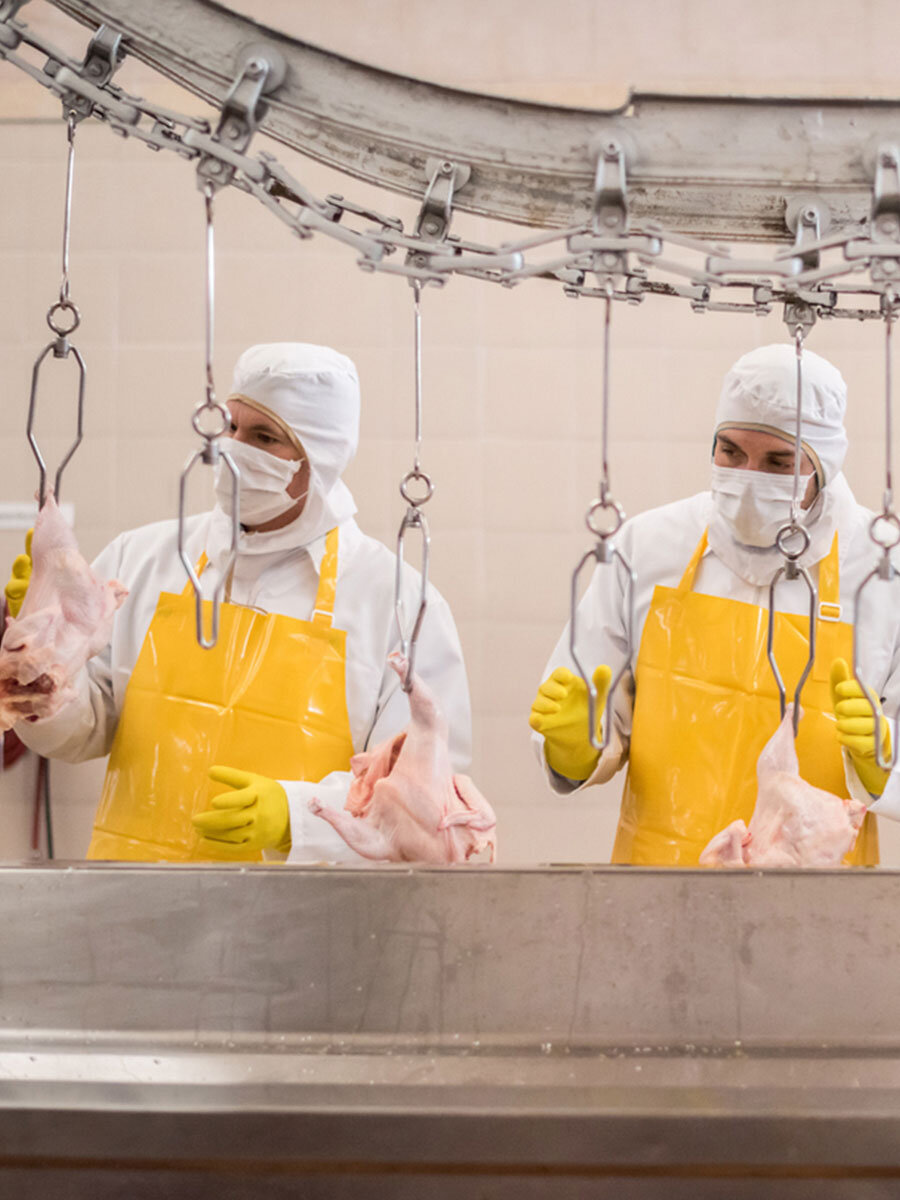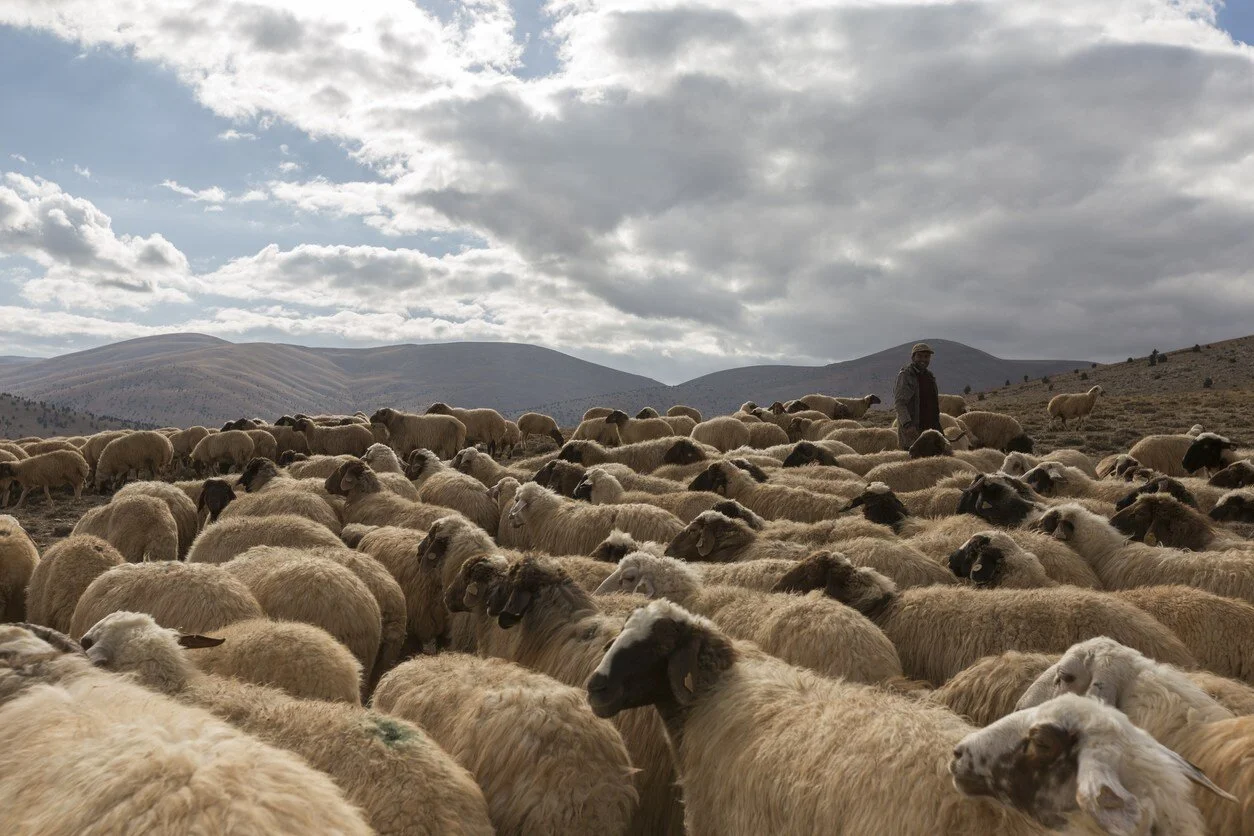
Slaughterhouse Labor
Workers in the meatpacking industry have been deeply affected by the consolidation in that industry. The top four processors in each sector control between 50 and 80% of the market in beef, hogs, and poultry. The power of these companies makes it easier for the managers of these firms to block unions, drive down wages, and force employees to work faster and in less safe environments.
Read More
Today, more than 500,000 people work in meat slaughtering and processing. In 2018 their average annual salary was $28,450, just above the federal poverty line for a family of four. Slaughterhouse employees are predominantly people of color and immigrants. Nearly 30% of slaughterhouse workers were born outside the United States and many are undocumented.
Meatpacking is one of the most dangerous professions in the world. Workers must navigate slippery floors, perform repetitive motions for long hours, wield sharp knives and industrial saws, and process hundreds, if not thousands, of animals each day. At these breakneck paces, one wrong move can result in anything from a laceration or a pulled muscle, to far more gruesome and permanent injuries. The Food Chain Workers Alliance reports that 65% of meatpacking and food processing workers have been injured on the job. Data reported to the Occupational Safety and Health Administration in 2015 revealed that amputations and hospitalizations are a regular occurrence at Tyson Foods meatpacking plants.
And these numbers probably understate the problem. According to the United Food and Commercial Workers, the Bureau of Labor Statistics and the Occupational Safety and Health Administration “miss from 20 percent to as much as 50 percent of the nation’s workplace injuries.” Also, slaughterhouse employees, and especially undocumented workers, are often fearful of retaliation if they report an injury.
Meatpacking has always been a dirty and dangerous job, but conditions are much worse today than a generation ago. Since the 1980s neoliberal policies that promoted consolidation, deregulation, and union busting have slashed workers’ wages, increased workplace hazards, and diminished workers power to advocate for better conditions.
For instance, over the last 30 years slaughterhouse companies have greatly increased the speed of their “disassembly” lines, as consolidation has left each company responsible for more of the country’s share of processed meat. In the 1970s, typical line speed for the beef industry was around 175 cattle per hour. Now, some plants slaughter more than 400 animals per hour. In the chicken industry, the Streamlined Inspection System line speed standard is 70 chickens per minute, but new inspection systems increased this limit to 140 birds per minute and the Trump administration proposed a rule in 2020 that would allow plants to run at 175 chickens per minute. This proposal came after USDA already granted waivers for some plants to run at these breakneck speeds during the COVID-19 pandemic. In hog processing, USDA lifted all limits on line speeds in 2018, which can reach 1,300 animals per hour.
These new pork and poultry inspection programs also shift more inspection duties from federal employees to plant staff, who feel pressure from management to keep lines running. Such self-inspection at higher speeds makes it more likely that diseased and contaminated animals pass through the line unchecked.
In many cases, plant managers have ramped up line speed without accompanying growth in the number of workers on the line, meaning that each worker must perform more actions every minute. When a company increases line speeds without increasing the number of workers on the line, this increases the likelihood of injuries. Faster lines also put more workers in closer contact, facilitating the spread of COVID-19 through meatpacking plants, sickening tens of thousands of workers and killing over 200.
Slaughterhouse jobs were once highly respected and, by the mid-twentieth century, thanks mainly to successful unionization, provided many workers with middle-class salaries. As recently as 1979, meatpacking workers’ wages were above the national manufacturing average at roughly $28 per hour, adjusted for inflation. But in the 1980s President Ronald Reagan ushered in an era of union busting and permissive merger policy. Meatpackers began to compete with one another by slashing wages. Packers closed union plants only to reopen them with lower wages and no union contract. At the same a wave of massive takeovers consolidated power among a handful of cost-cutting packers. For example, the top four packers controlled just 26% of the beef market in 1976, but by 2002, the top four dominated 85% of the market – and still do today. All told, over the course of a decade meatpacking wages fell from 15% above the national average to 20% below it.
Slaughterhouse workers today continue to fight for better pay and protections, but they face more obstacles. For one, packers made a concerted effort to move plants from urban centers to rural areas and to states more hostile to unionization. This shift also changed the demographics of meatpacking, as packers recruited a more vulnerable and mobile immigrant workforce to fill rural plants. Today, roughly half of meatpacking workers are immigrants and language barriers or insecure immigration status make these workers less likely to contest mistreatment or exercise their legal rights.
Powerful packers also leverage their position as one of few employers in a given region to suppress unionization and intimidate workers. The National Labor Relations Board has found management at Tyson and Perdue plants in North Carolina, Arkansas, and Alabama guilty of illegally threatening workers’ freedom of association.
In spite of these challenges, there is still a strong union presence in some packing plants: in 2020, 60% of all pork and 70% of all beef came from UFCW unionized plants. Workers have also won union victories in the post-Regan era. In 2008, workers at a North Carolina slaughterhouse owned by Smithfield successfully voted to join the UFCW after nearly 15 years of managerial intimidation, immigration raids, and firings aimed to quash organizing. Workers in slaughterhouses owned by National Beef, Farmland Foods (a Smithfield subsidiary), and JBS have also voted to join the UFCW in recent years.
In the chicken and pork industry, non-union grassroots worker-based organizations such as Venceremos in Arkansas or the Rural Community Workers Alliance have also organized for workers protections and even sued dominant meatpackers, particularly in the wake of the COVID-19 pandemic.
Farmworkers
The National Center for Farmworker Health estimates that there are about 3 million farmworkers in the United States. More than a million work in California alone. Farmworkers face many on-the-job risks, both environmental and social. Constant exposure to pesticides, insecticides, and fertilizers can result in birth defects, asthma, and cancer. Farmworkers are frequently victims of wage theft and many live in constant fear of immigration raids and deportation.
Read More
Farmworkers are especially vulnerable due to the lack of transparency and accountability surrounding their working conditions. As consolidated, large-scale corporate growers have dominated farming, the management of farm labor is increasingly outsourced to contractors. These contractors act as intermediaries between farmworkers and growers, and provide loopholes for large-scale growers to avoid providing basic employee protections. Contractors are rarely inspected, despite their large role in the labor market; in California, for example, contractors supply anywhere between 50 and 75% of farmworker labor in that state. Nationally, labor contractors hire about 20% of farmworkers in the US.
According to the latest National Agricultural Workers Survey, about 68% of farmworkers are men, 83% identified as Hispanic, and roughly half were undocumented. While most U.S. farmworkers are born abroad, around 30% are U.S. citizens and 78% have been in the U.S. for at least 10 years. Just under 20% of farmworkers traveled 75 miles outside their home base for work or followed the harvest as a migrant worker, down considerably from the 1990s when migrating farmwork was more common. The use of temporary foreign guest workers on H-2A visas, however, continues to rise and these workers comprised 10% of the farm labor force in 2019. According to data collected by the Food Chain Workers Alliance, more than 50% of agricultural workers earn a sub-minimum—below poverty—wage. The average reported farmworkers’ personal income in 2015 was just $18,750.
Since its inception, the commercial American agriculture system has relied on an oppressed and disenfranchised Black and Brown workforce. In 1619 the first Black African enslaved people arrived in Virginia to work farms, and enslaved Black laborers fueled American plantation agriculture for nearly 250 years. After the 13th amendment prohibited slavery, with the exception of punitive prison labor, many former enslaved Black people continued to work the fields as indebted sharecroppers. In the mid-19th century immigrants from China, Japan, and the Philippines also entered the Southern sharecropping system and worked in the growing west coast fruit, vegetable, and wine industries.
Recruiting workers from other countries to temporarily come to the U.S. for seasonal agricultural work was not widespread until World War I, when war-driven labor shortages prompted the U.S. to establish a guest worker program with Mexico in 1917. The program ended in 1922 but was followed by a much larger guest worker agreement with Mexico in WWII, formerly called the Mexican Farm Labor Program but widely known as the “bracero” program after the Spanish word for laborer. This program brought about 4.5 million Mexican workers to do temporary agricultural work in the US between 1942 and 1964, when the program ended.
Farmworkers have never had the same protections and legal rights as other workers. Most critically, farmworkers are excluded from key aspects of the Fair Labor Standards Act (FLSA), a worker protection law passed in 1938. Agricultural workers initially weren’t included in any of the protections provided by the FLSA. But in 1966 an amendment to the Act guaranteed farmworkers minimum wage and child labor provisions. However, to this day farmworkers are still excluded from overtime provisions and hour guarantees. And their working conditions are frequently well below the legally guaranteed standards that many workers rely on.
Farmworkers have frequently launched their own campaigns for better pay, living conditions, health care, and hours. But farmworkers are limited in their abilities to organize because of their exclusion from the National Labor Relations Act. Farmworkers who do attempt to organize can face extreme consequences, such as withheld wages, violence, or deportation. As a result, only about 1% of farmworkers interviewed by the United Farm Workers in 2011 were unionized.
Despite the risks, farmworkers have successfully won campaigns across the country. Throughout the 1960s and 70s, the United Farm Workers, under the direction of Cesar Chavez, used boycotts and strikes to help end the bracero program, draw attention to abusive work conditions, and attain higher wages.
Today, farmworker organizing is happening across the country. The Coalition of Immokalee Workers (CIW), a group that represents tomato pickers in and around Immokalee, Florida, has achieved particular success. The CIW works with restaurant chains, supermarkets, and distributors to raise the wages of tomato pickers and bring awareness to the plight of farmworkers. The group has signed 11 multi-billion-dollar food retailers onto their Campaign for Fair Food. And the CIW has helped to prosecute employers in nine cases of modern-day wage slavery, liberating 1,200 farmworkers from enslavement in Florida.












